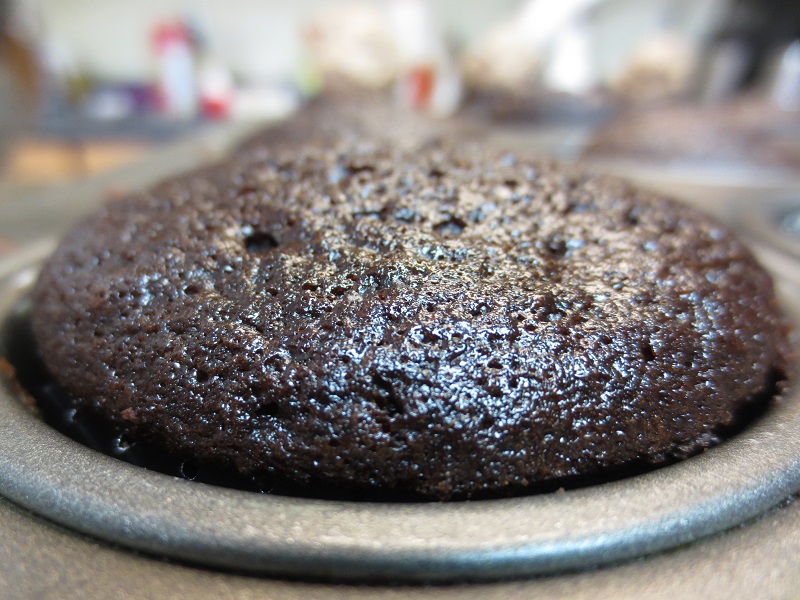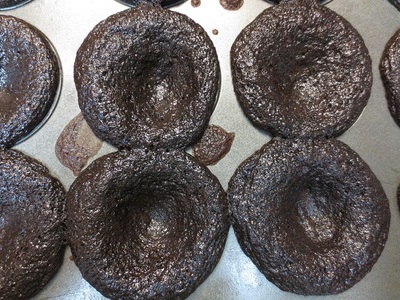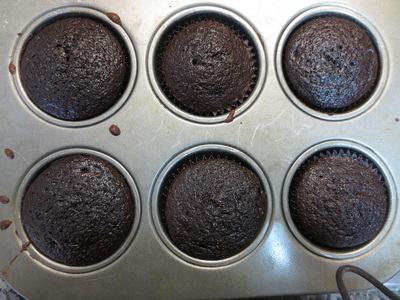
Pretty nice-looking cupcake, isn’t it? Beautifully domed, perfectly sized for the muffin tin cup. And the inside was moist and delicious, in spite of the fact that I overbaked it a bit. (Note to self: Be sure to use the oven timer that measures minutes and seconds, not hours and minutes, when baking something that requires minutes. If I hadn’t realized at about the 20-minute mark that I’d set the wrong timer, the above would be a picture of a lump of chocolate coal. As it was, they probably baked about five minutes more than necessary.) I did frost these with an unbelievably delicious chocolate buttercream, but I’ll be discussing that recipe in a later post.
Below are are two comparison shots of the cupcakes this week and the ones last week.


Last week’s version was a disaster, as you can see on the left. They’ve collapsed in the middle and spread out over the top of the pan, and they were impossible to remove neatly. Their texture was very gooey. (Although one women said that she preferred them over this week’s version!) It was no big deal for this particular occasion, as everyone was very understanding, the cupcakes tasted good, and it was an informal meal. But I wanted to solve the problem and was very puzzled by the results. The recipe was from Martha Stewart, and I had checked and re-checked my ingredients since it was my first time making it. So what had gone wrong? Then it hit me: I hadn’t done any adjustments for high altitude. Normally, for something with a coarse texture and thick batter, such as muffins, it doesn’t matter too much. I usually don’t bother with any changes. But for something light and fluffy, especially with a thinner batter that is dependent on the leavening for most of its structure, the altitude makes a huge difference. I went online and looked up the adjustments given by my old friend King Arthur Flour, and by implementing them I was able to achieve the results that you see on the right. You can see the complete table with all the technical information by following the link, but I followed are listed below. In general, the changes are tied to the lower air pressure at high altitudes, causing baked goods to rise too quickly and then collapse. That is obviously what happened to the first batch of cupcakes. But remember–just to make things confusing, these adjustments are not always necessary. For this recipe they are. I would also say, in general, that for small items such as cupcakes, the high altitude adjustments won’t matter as much as for a big item such as a layer or sheet cake. (Yet another reason to make cupcakes instead of cakes!) But I liked this recipe enough that I was willing to fiddle with it.
Here are the adjustments I used:
|
Recipe Element
|
Change
|
|
Oven temperature
|
Increase 15-25 degrees (Use lower temp. for chocolate items.)
|
|
Bake time
|
Decrease slightly, perhaps 10%
|
|
Sugar
|
Decrease by 1 tablespoon per cup
|
|
Liquid
|
Increase by 3 tablespoons
|
|
Flour
|
Increase by 2 tablespoons
|
|
Leavening
|
MOST IMPORTANT CHANGE;
For altitudes of 5,000 feet (where I live), cut leavening in half. |
Easy Dark Chocolate Cupcakes
Adapted from just the cake part of Martha Stewart's "Salted Caramel Six-Layer Chocolate Cake."
Ingredient amounts in parentheses are for high altitude baking, 5,000 feet or higher.
Ingredients
- 3 cups all-purpose flour add 2 tablespoons extra
- 3 cups sugar minus 3 tablespoons
- 1 1/2 cups unsweetened Dutch-process cocoa powder*
- 1 tablespoon baking soda 1 1/2 teaspoons
- 1 1/2 teaspoons baking powder 3/4 teaspoon
- 1/2 teaspoon salt
- 4 eggs
- 1 1/2 cups buttermilk**
- 1 1/2 cups warm water add 3 tablespoons extra
- cup 1/2 plus 2 tablespoons vegetable oil--anything but olive oil
- teaspoons 2 vanilla
Instructions
-
Mix the dry ingredients (flour through saltogether on low speed in either the bowl of a standing mixer with the paddle attachment or a large mixing bowl with a hand mixer. (Put buttermilk powder in at this point if you're using.) In a separate, smaller bowl, whisk together the wet ingredients, eggs through vanilla. (If you're using the buttermilk powder, then you'll just use the total amount of liquid for the warm water and buttermilk combined, 3 cups or 3 cups plus 3 tablespoons if adjusting for high altitude.) Pour the wet ingredients over the dry and beat until smooth, about 3 minutes. Be sure to scrape the bottom of the bowl with a spatula to totally incorporate the dry ingredients!
-
Divide batter among 4 12-cup muffin tins, filling each one only about half full. Yes, this makes a lot of cupcakes. You can cut the recipe in half, but then you'll have to do all the fiddly adjustments for high altitude if you're using those. So this may be a recipe you save for when you're making cupcakes for the entire fifth grade, or something like that. Bake at 365 degrees for 15 minutes, then test with a toothpick, which should come out clean. Cool in pans for at least five minutes before taking them out so that they have a chance to firm up. Frost as desired.
Recipe Notes
*Dutch-process cocoa is darker and less acidic than regular cocoa. It can be hard to find, but you can't substitute regular cocoa for Dutch-process without also fiddling with the leavening to allow for the different acidity. Hershey's has a "Special Dark" brand of cocoa that is a blend of regular and dark cocoa and will work fine for this recipe. I have recently been using a brand that Costco carries, Rodelle Gourmet Baking Cocoa, European Dutch Processed, and have had good luck with it. If Costco stops carrying it I'll go back to the Hershey's Special Dark.
**Buttermilk is a difficult ingredient to keep on hand, as you don't usually need a lot of it for a recipe and it doesn't keep well. I always have a can of buttermilk powder on hand and use that. The directions are on the container and it's very easy to use. For each 1/4 cup of buttermilk called for in the recipe you use 1 tablespoon of the powder and 1/4 cup of water. Mix the buttermilk powder in with the dry ingredients and the water in with the wet ones (obviously!). You can also do the lemon juice or white vinegar trick, by adding 1 tablespoon of either to 1 cup of milk and letting stand for 5 minutes before using. I always feel that doing it that way is cheating, but hey! Sally over at Sally's Baking Addiction does it that way, and she's the pickiest person around when it comes to baking. I'll stick with my buttermilk powder, though. Your call.






